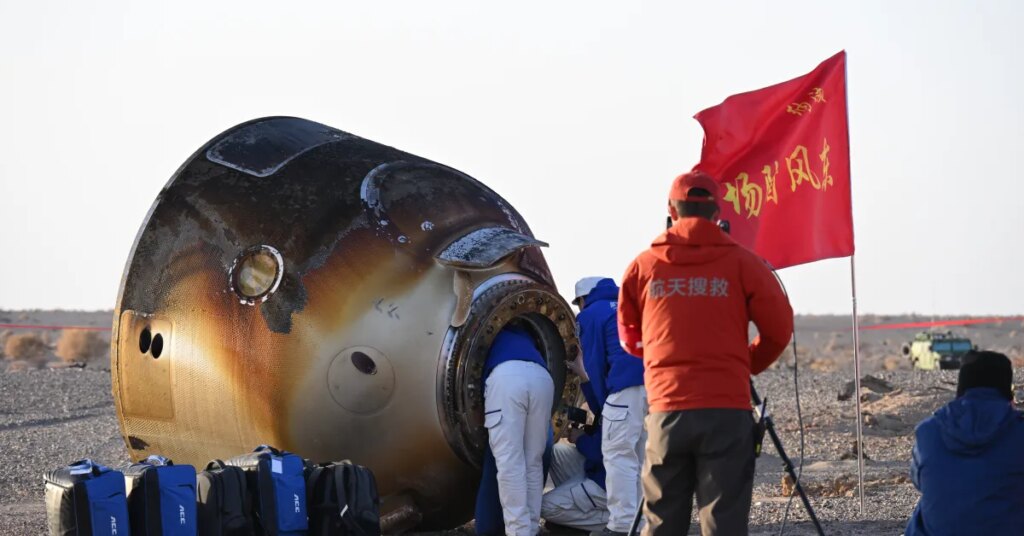No trip to space can be counted a success unless you make it safely back to Earth. That’s a lesson American astronauts Butch Wilmore and Suni Williams learned when their intended eight-day stay aboard the International Space Station (ISS) in 2024 wound up lasting nine months, due to thruster problems in their Boeing Starliner spacecraft that left them without a ride home. And it’s a lesson that was learned anew this week by the taikonauts—Chinese astronauts—Chen Dong, Chen Zhongrui, and Wang Jie. The trio arrived at China’s Tiangong Space Station aboard their Shenzhou-20 spacecraft on April 24, and were set to come home on Nov. 5, handing the keys to the station over to the three-person crew of Shenzhou-21, who arrived on Oct. 31.
[time-brightcove not-tgx=”true”]
But that was not to be. Not long before Shenzhou-20 was set to carry the three home it was struck by a piece of space debris, leaving cracks in one of its windows. That can be deadly in a spacecraft that is supposed to remain airtight both in the vacuum of space and in the steadily thickening atmosphere as it returns to Earth.
“The Shenzhou-20 manned spacecraft is suspected of being struck by small space debris, and impact analysis and risk assessment are underway,” Chinese space officials reported in a Nov. 4 post on Weibo, the Chinese social media platform. “To ensure the safety and health of the astronauts and the complete success of the mission, it has been decided that the Shenzhou-20 return mission, originally scheduled for November 5th, will be postponed.”
A week later, with no solution yet to the problem, they took something of a nothing-to-see-here approach. Under a release headlined “The Shenzhou-20 Astronaut Crew’s Return Mission Is Progressing Smoothly,” they wrote, “Currently, the space station complex is in normal condition… The Shenzhou-20 astronaut crew is living and working normally and is conducting in-orbit scientific experiments together with the Shenzhou-21 astronaut crew.”
Ultimately, on Nov. 14, mission directors chose the only option they could, which was to leave the potentially crippled Shenzhou-20 spacecraft attached to the station and bring the crew home in the Shenzhou-21 craft —the one that had been meant to wait around as a ride home for its own original operators. (The sequential ordering refers to the number of the mission.) The astronauts thumped down in Inner Mongolia at 3:45 a.m. EST after 204 days in space.
“The path of human space exploration is not smooth,” said commander Cheng Dong when he emerged from the capsule, according to a translation provided by the Associated Press. “It’s filled with difficulties and challenges. But that is exactly why we choose to walk this path.”
The Shenzhou-21 taikonauts are still walking it, flying aboard the station without any safe means of getting away in the event of an emergency. According to a report by Xinhua, the government’s official news agency, an empty Shenzhou-22 spacecraft “will be launched at an appropriate time in the future,” and will dock with the station, allowing the crew to leave after their six-month rotation ends. Until then, they are stuck.
Small debris, big problem
That, of course, is no way to fly—or at least no way to fly safely. But debris collisions like the one that took Shenzhou-20 out of service are only likely to become more common. Ever since the old Soviet Union launched Sputnik, the first artificial satellite, in 1957, spacefaring countries have used Earth orbit as something of a cosmic dumping ground, discarding spent rocket stages, defunct satellites, and bags of trash from crewed spacecraft, as well as bolts, screws, lost tools, flecks of paint, and more. According to a new study published by Kathleen Curlee and Lauren Kahn, research analysts at Georgetown University’s Center for Security and Emerging Technology, there are currently more than 34,000 objects larger than 10 cm (roughly 4 in.), circling Earth in a debris band moving at more than 17,500 mph, or up to 23 times the speed of a bullet.
In addition, there are uncounted swarms of much smaller flecks that may be barely visible to the eye but pack a powerful destructive wallop moving at such speeds. Spacewalking ISS astronauts routinely report seeing a scattering of dents in the side of the station, as if it has been hit by orbital birdshot. On multiple occasions, crews have been ordered to shelter in place in the Russian Soyuz or American Dragon spacecraft attached to the ISS, when ground controllers spot debris that may intersect the station’s orbit. In the event of a serious collision they would be ordered to undock and fly home.
“There are tens of millions of smaller, untraceable pieces that can still wreak havoc,” says Curlee, the study co-author. “It is not just sheer luck that we have not seen more collisions: operators in space routinely maneuver to avoid colliding with debris. But this is the first time a Chinese return mission has been delayed by debris.”
That, she says, is both ironic and somewhat just, since China has contributed at least as much to the debris problem as any other country or private company. In 2007, the Chinese military tested its anti-satellite technology by launching a kill vehicle at one of its own defunct weather satellites. The missile scored a hit, producing more than 2,000 bits of debris on the 10-cm.-or-greater scale and tens of thousands of smaller bits. NASA called the flying junk “the most severe artificial debris cloud in Earth orbit since the beginning of space exploration.”
The cloud is still there. Orbits of the Earth ultimately decay, as faint traces of the exosphere produce drag, causing a circling object eventually to plunge into the atmosphere and incinerate. But the higher the orbit is, the longer the decay takes. The Chinese weather satellite was moving in a near vertical polar orbit 537 miles up, so its remains are still flying free.
The only solution to space junk
Space debris is not everywhere. Like automobile traffic, it is concentrated into lanes or orbital avenues. The band closest to the planet is known straight-forwardly as low-Earth orbit (LEO), extending from 99 to 1,200 miles up. Medium-Earth orbit (MEO) ranges from 1,240 to 22,300 miles up. And, finally, geostationary orbit (GEO) holds the high ground at more than 22,300. Satellites in GEO are at such nose-bleed altitudes that it takes them almost a day to inscribe one circle around the Earth, matching the planet’s speed of rotation. The result is that the satellite forever hovers over a specific spot on the ground, which is ideal for communications craft that have to cover a fixed footprint at all times.
Unlike earthly junk, space junk can never be cleaned up. Various experimental technologies have been proposed over the years to collect it and nosedive it all into the atmosphere, but nothing has come even close to being practical or reliable. “There is no cost-effective way to remove debris already in space,” says Curlee. “Debris-removal technology is currently experimental and far from scalable.”
The only solution is to accept the mess we’ve got, avoid it when we can, and resolve not to add more to the problem, even as the estimated $1.8 trillion space economy increases our reach into orbit and beyond. “The most immediate solution is prevention,” says Curlee. “There need to be stricter international laws and regulations governing end-of-life disposal mechanisms for space-based tech.”
Shenzhou-20 was a warning shot—one that the taikonauts managed to survive. Next time we might not be so lucky.
The post China’s Imperiled Astronauts Illustrate the Dangers of Space Debris appeared first on TIME.




